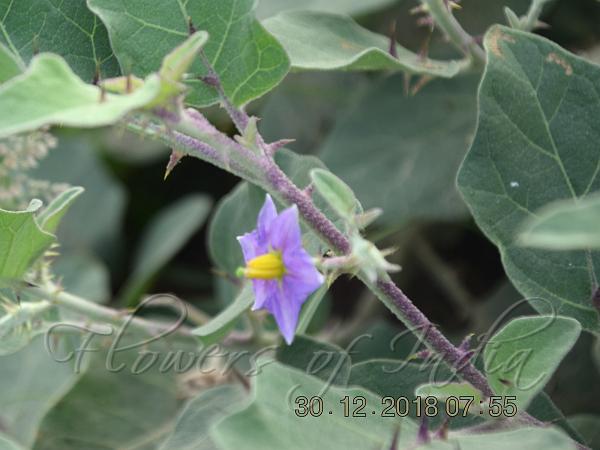|
| Bitter Brinjal |
|

|

| File size | 420661 |
| Original date | 12/30/18 7:55 AM |
| Resolution | 2000 x 1500 |
| Flash | Flash did not fire |
| Focal length | 98.0mm |
| Exposure time | 1/160s |
| Aperture | 5.6 |
| Focus Distance | |
| Metering Mode | Multi-segment |
| Camera make | NIKON CORPORATION |
| Camera model | NIKON D3300 |
| Sensor type | OneChipColorArea |
|
|
|
|
Photo: |
Botanical name: Solanum incanum Family: Solanaceae (Potato family)
Synonyms: Solanum sanctum, Solanum unguiculatum
Synonyms: Solanum sanctum, Solanum unguiculatum
Bitter Brinjal is a herb or soft wooded shrub up to
1.8 m in height with spines on the stem, stalks and sepals and with
velvet hairs on the leaves. Flowers are pale to deep blue, mauve or
purple. The leaves are alternate, ovate with slightly wavy margins,
especially on young leaves, with a grey-green upper surface and a
green-white lower surface. The flowers are often borne in the leaf
axils, sometimes solitary or in clusters of a few flowers. The yellow
or white calyx is fused, the purple flower regular, bell- or wheel
shaped with 5 stamens. The globular fruits are yellow at the beginning,
becoming black later on. Fruit are mottled or striped green and light
green, yellow when ripe. Bitter Brinjal is widespread in the Tropical
world. Flowering: November-March.
Medicinal uses: is effective for control of
cattle ticks when used as water extracted concoction. The fruit of S.
incanum are used in Kenya for treatment of skin mycotic infections.
is effective for control of
cattle ticks when used as water extracted concoction. The fruit of S.
incanum are used in Kenya for treatment of skin mycotic infections.
Medicinal uses:
 is effective for control of
cattle ticks when used as water extracted concoction. The fruit of S.
incanum are used in Kenya for treatment of skin mycotic infections.
is effective for control of
cattle ticks when used as water extracted concoction. The fruit of S.
incanum are used in Kenya for treatment of skin mycotic infections.
| Identification credit: S. Kasim | Photographed in Radhapuram, Tamil Nadu. |
• Is this flower misidentified? If yes,